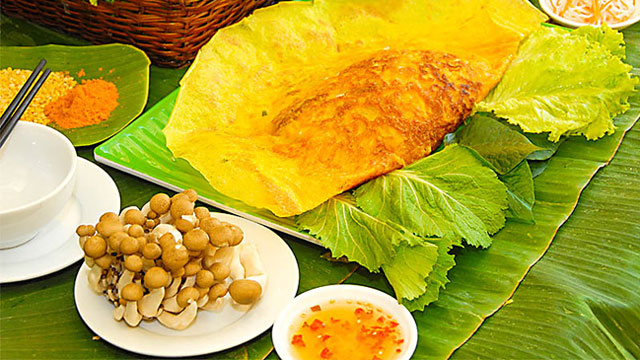Every festival gathering, relatives in the river country invite each other to pour pancakes. The cake sounds simple, but there are dozens of things in it.
At that time, every time I poured pancakes, I had to get up early to soak the rice and then grind the flour. But the water to soak the rice must be clean so that the flour is not sour. Then mix the flour to have a beautiful golden color, add a little turmeric topped with finely chopped scallions, then season to taste and fry. Banh xeo must be fried on charcoal fire to be crispy and not burnt.
Depending on the place, people make different cakes. The vegetables served with each place also have a different taste. Like in Vinh Long, people often use it with convex sand vegetables. A banquet table with a basket of fresh green vegetables, a crispy pancake and a cup of sweet and sour fish sauce dropped on a few pickled red radish stalks is enough for a full meal.
Now, pouring pancakes is not as extreme as it used to be. And the juicy atmosphere of a meal of pancakes still urges people to shout “hey, pour pancakes tomorrow” for fun.
Source: Collected internet.
Eight UNESCO world heritage sites stretch across Vietnam. Each place offers interesting perspectives on local life and majestic natural beauty. The Imperial Citadel and Hue mausoleums take you back to the Nguyen Dynasty full of ups and downs. Hoi An ancient town was once a bustling meeting point for ships and traders around the world. Throughout other provinces and cities, you will encounter ancient relics, poetic scenes, and vivid pieces that create the picture of Vietnamese heritage.
The specialties of each region of Vietnam carry within themselves the local lifestyle and the quintessence of nature there. The North cherishes delicate recipes, like a delicious bowl of bun thang that must be prepared for many hours. In the Central region, royal culinary traditions and typical spices blend in unique dishes such as lotus rice or spring rolls. Southern braised fish and sour soup come from abundant seafood resources, the pride of the Mekong Delta.
Costume is one of the important factors that differentiate Vietnamese culture from other countries in the world. The costumes not only mark the cultural traditions and customs of the Vietnamese people, but they are also the breath and soul of a nation.
Ao Dai not only enhances the gentle and loving beauty of Vietnamese women, but it also shows discreetness, modesty and strange charm. Ao dai today is becoming more and more diverse in shape, color, and pattern, but it still retains its traditional appearance.
